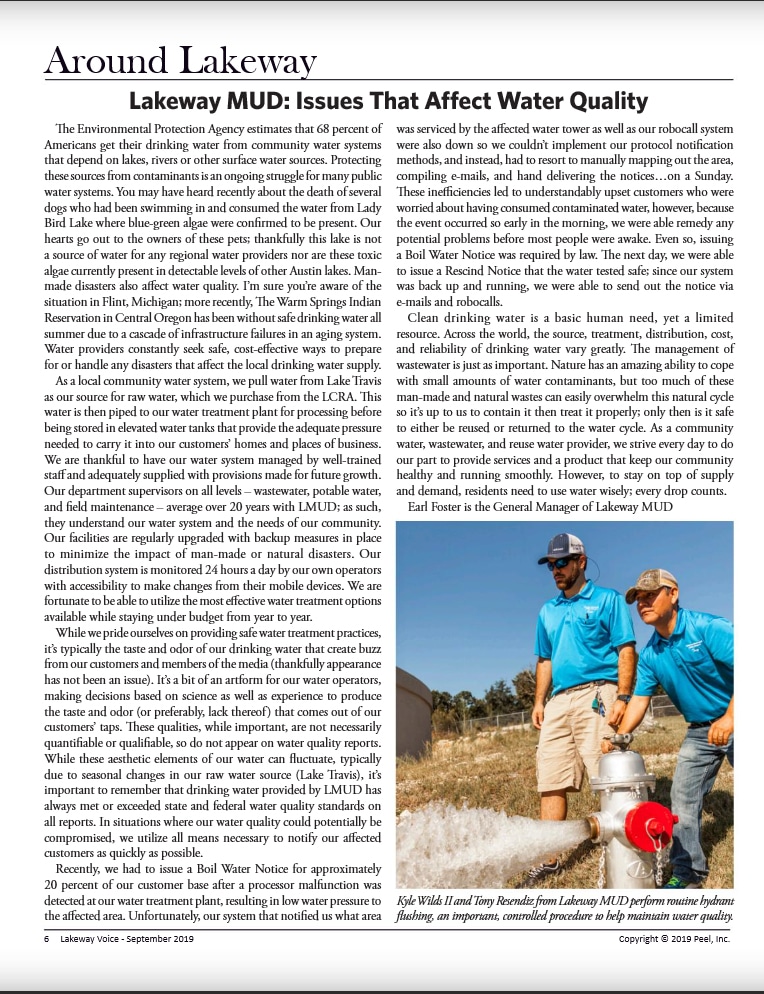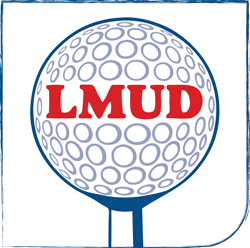Issues That Affect Water Quality

As published in Lakeway Voice, September 2019 .
Issues That Affect Water Quality
The Environmental Protection Agency estimates that 68 percent of Americans get their drinking water from community water systems that depend on lakes, rivers or other surface water sources. Protecting these sources from contaminants is an ongoing struggle for many public water systems. You may have heard recently about the death of several dogs who had been swimming in and consumed the water from Lady Bird Lake where blue-green algae were confirmed to be present. Our hearts go out to the owners of these pets; thankfully this lake is not a source of water for any regional water providers nor are these toxic algae currently present in detectable levels of other Austin lakes. Man-made disasters also affect water quality. I’m sure you’re aware of the situation in Flint, Michigan; more recently, The Warm Springs Indian Reservation in Central Oregon has been without safe drinking water all summer due to a cascade of infrastructure failures in an aging system. Water providers constantly seek safe, cost-effective ways to prepare for or handle any disasters that affect the local drinking water supply.
As a local community water system, we pull water from Lake Travis as our source for raw water, which we purchase from the LCRA. This water is then piped to our water treatment plant for processing before being stored in elevated water tanks that provide the adequate pressure needed to carry it into our customers’ homes and places of business. We are thankful to have our water system managed by well-trained staff and adequately supplied with provisions made for future growth. Our department supervisors on all levels – wastewater, potable water, and field maintenance – average over 20 years with LMUD; as such, they understand our water system and the needs of our community. Our facilities are regularly upgraded with backup measures in place to minimize the impact of man-made or natural disasters. Our distribution system is monitored 24 hours a day by our own operators with accessibility to make changes from their mobile devices. We are fortunate to be able to utilize the most effective water treatment options available while staying under budget from year to year.
While we pride ourselves on providing safe water treatment practices, it’s typically the taste and odor of our drinking water that create buzz from our customers and members of the media (thankfully appearance has not been an issue). It’s a bit of an artform for our water operators, making decisions based on science as well as experience to produce the taste and odor (or preferably, lack thereof) that comes out of our customers’ taps. These qualities, while important, are not necessarily quantifiable or qualifiable, so do not appear on water quality reports. While these aesthetic elements of our water can fluctuate, typically due to seasonal changes in our raw water source (Lake Travis), it’s important to remember that drinking water provided by LMUD has always met or exceeded state and federal water quality standards on all reports. In situations where our water quality could potentially be compromised, we utilize all means necessary to notify our affected customers as quickly as possible.
Recently, we had to issue a Boil Water Notice for approximately 20 percent of our customer base after a processor malfunction was detected at our water treatment plant, resulting in low water pressure to the affected area. Unfortunately, our system that notified us what area was serviced by the affected water tower as well as our robocall system were also down so we couldn’t implement our protocol notification methods, and instead, had to resort to manually mapping out the area, compiling e-mails, and hand delivering the notices…on a Sunday. These inefficiencies led to understandably upset customers who were worried about having consumed contaminated water, however, because the event occurred so early in the morning, we were able remedy any potential problems before most people were awake. Even so, issuing a Boil Water Notice was required by law. The next day, we were able to issue a Rescind Notice that the water tested safe; since our system was back up and running, we were able to send out the notice via e-mails and robocalls.
Clean drinking water is a basic human need, yet a limited resource. Across the world, the source, treatment, distribution, cost, and reliability of drinking water vary greatly. The management of wastewater is just as important. Nature has an amazing ability to cope with small amounts of water contaminants, but too much of these man-made and natural wastes can easily overwhelm this natural cycle so it’s up to us to contain it then treat it properly; only then is it safe to either be reused or returned to the water cycle. As a community water, wastewater, and reuse water provider, we strive every day to do our part to provide services and a product that keep our community healthy and running smoothly. However, to stay on top of supply and demand, residents need to use water wisely; every drop counts.
Photo caption: Kyle Wilds II and Tony Resendiz from Lakeway MUD perform routine hydrant flushing, an important, controlled procedure to help maintain water quality.



 You are now being redirected to the WaterSmart page.
You are now being redirected to the WaterSmart page.